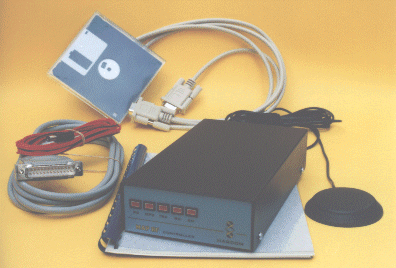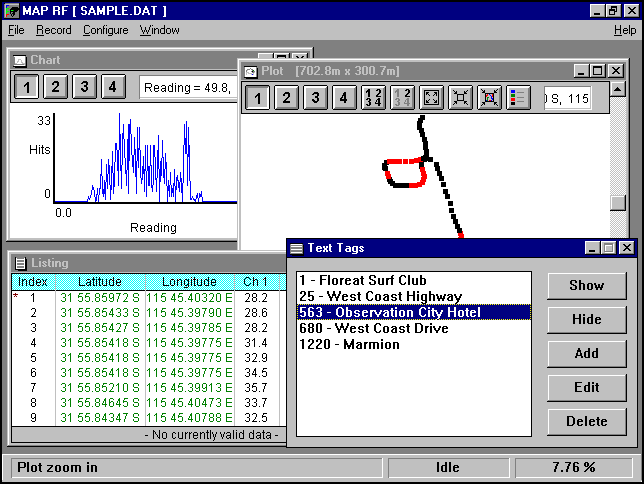MAP RF v2
RF site survey equipment
Note: This hardware has been superseded. Please see MAP RF v3.
MAP RF gives you the power to conduct detailed RF site surveys without the need to buy or hire expensive equipment. This portable, compact unit is both powerful and affordable, just compare MAP RF to alternative products on the market.

MAP RF monitors the signal level within almost any receiver which you connect it to. Position data is provided by a GPS built within the MAP RF unit. These two sources of data are fed to a PC via the serial RS232 port. Software running on the PC processes the information and displays it in several ways including a colour coded plot and text listing.
MAP RF consists of three main parts; a) a receiver, b) the controller and c) a laptop running the software.

a) The receiver can be any device supplied by the user which produces a voltage level to show some signal level. This typically will be a two way radio or a wide band receiver but can also be a mobile phone, a fuel gauge or even an electronic altimeter. Voltage levels, by default, are expected to be between 0 - 5 vdc, but the controller can be configured for almost any voltage range.
b) HASCOM's MAP RF Controller is a microprocessor based unit which can take readings of voltage levels using analogue to digital convertors (ADC's) from 4 sources simultaneously. It has a built in 8 channel differential capable GPS to provide latitude and longitude position information. There is a serial port to transfer the data a PC or laptop computer. There is also an accessory port which provides additional RS232 support, for instance to control certain receivers. Raw measurements of signal level are taken four times a second and averaged to give a value for the second. The average signal level value and the position information are fed to the PC once per second.
c) The MAP RF software provides control of the system, receives and stores all the measurement information from the controller. The measurements are calibrated by use of an easily defined calibration table to produce accurate readings in any units (eg dbm, mW, etc). The readings are displayed in several formats including a text listing, a trend chart and a colour coded plot. Any reading can have a text tag attached to it to help define the reading. The information can be exported in to a text file in several formats (eg for import into a spread sheet). The colour coded plot can be printed to fill a page or scaled and printed on a transparency for overlay on a map.

MAP RF Features:
- The signal strength reading from up to four receivers is automatically measured four times a second and averaged over the second.
- Position information is provided by an 8 channel GPS every second.
- Information is gathered by a simple 16 bit Linux application and displayed in three powerful ways; a text listing, a trend chart and a colour coded plot.
- Readings can be taken at an interval of 1 second or up to several hours.
- Full calibration of each individual receiver is easily accomplished with a known variable signal source to provide actual units, ie dbm or mW.
- Data automatically written to disk in case of power failure during recording.
- Ability to filter invalid readings, for example when the GPS was not tracking.
- GPS configuration is fully controlled and a self test can performed from within the software.
- Results can be printed as a text listing, plotted on transparency for overlay on a map or saved to a text file for import into other software, such as a spreadsheet.
- Full online help is provided for the software and hardware.
Recently added Features:
- MAP RF now supports differential GPS operation.
- Readings can now have a text tags associated with them.
- The plot window now has an indication of the scale in the title bar.
- The recording interval can now be set for a distance or a time.
- The analogue to digital converters in the controller unit now read the signal levels four times a second and then average the readings to provide an average reading for the second.
- The serial communications between the controller and the software has been enhanced.
